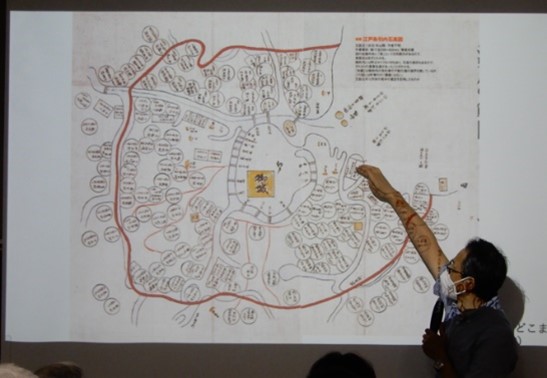Let’s extend our viewpoint from Minato City’s forests & sea to the world
Minato UNESCO Salon: SDGs-based Coexistence with Nature
– Let’s extend our viewpoint from Minato City’s forests & sea to the world-
Speaker: Professor SASAKI Tsuyoshi, Tokyo University ofMarine Science and Technology (TUMST)
Date: Thursday, July 1, 2021
Venue: Minato City Life-long Learning Center
We added SDGs as a subtitle to this serial salon series. As the subject of this salon, we selected the ocean which connects the whole world. At first, President Nagano introduced Professor Sasaki, who teaches marine environment and fishing in TUMST’s Department of Maritime Policy and Culture. Professor Sasaki has been instrumental in organizing an MUA’s Tokyo Bay cruise program which mainly addresses elementary school pupils and junior high school students, and which is supported by TUMST students. The said cruise program, based in Shibaura, has been increasingly popular.

Major topics in Professor Sasaki’s talk:
・Linkage of forests and the ocean, from the historical and geographic viewpoints.
・Examples of implemented activities: Workshops on maritime environment education/Observation of creatures on the Shibaura waterfront/Current level
of water pollution/What we can do to improve the environment in forests, rivers and the ocean.
Professor Sasaki started his speech by self-introduction:
・Up to 2006: worked for a high school of fishery in Iwate Prefecture and engaged in environmental education and supervision of oyster and scallop
farming. Learned the importance of field work and renewed awareness of the famous remark by Louis Agassiz – “Study nature, not books.”
・2006 – 2010: joined TUMST. Engaged in a curriculum to train educators to acquire skills for implementing field-study at junior and senior high school
levels.
・2010 – present: engaged in the field work for Konan Junior High School (water quality study and improvement) and for Takanawadai Senior High School
and a local Commerce High School (field study).
During his speech, Professor Sasaki touched upon the concept of “Ethnic Boundaries” proposed by a cultural anthropologist named Fredrik Barth. He also showed us a video which recorded a boat cruise in the Tokyo waterfront where students on board observed the natural environment of the forest and river. This made a good field study to observe the nature in Minato City. In 202, East Japan Railway Company came up with a waterfront concept and completed a “Takeshita Waters” facility next to the Hama Rikyu estate. It offers an effective platform to rejuvenate the Tokyo Bay. Tokyo is based on the Musashinodai Plateau, with a topographic feature of extensive ups & downs. With accumulated human efforts over centuries, Tokyo has evolved into a unique dynamic 3-dementional “Water City.”


Professor Sasaki recommended us to pursue the following seven objectives in our daily life, as a way to help revive the clean environment which once characterized the Edo Period:
1.Don’t allow any leftover at dinner table.
2.Wipe off stains from tableware before washing.
3.Use a water-filtering bag to prevent the outflow of garbage.
4.Don’t let oil flow down.
5.Use detergent which is odor-free and easy to dissolve in the sea.
6.Use the remaining water in the bathtub for washing.
7.Use soap or plant-based shampoo to wash your hair.
In 2021, the U. N. Decade of Ocean Science for Sustainable Development was kicked off. In this connection, Professor Sasaki established a URL titled “U. N. Ocean Lab” at http://www2.kaiyodai.ac.jp/~t-sasaki/Takeshiba/. The German government hosts the said U. N. initiative, connecting many laboratories worldwide, where Professor Sasaki’ lab is included to work as an Asian representative during the coming decade.
(Written by KOBAYASHI T., Standing Director, the Membership Committee, and translated by TANAHASHI S., the PR & Internet Committee)
